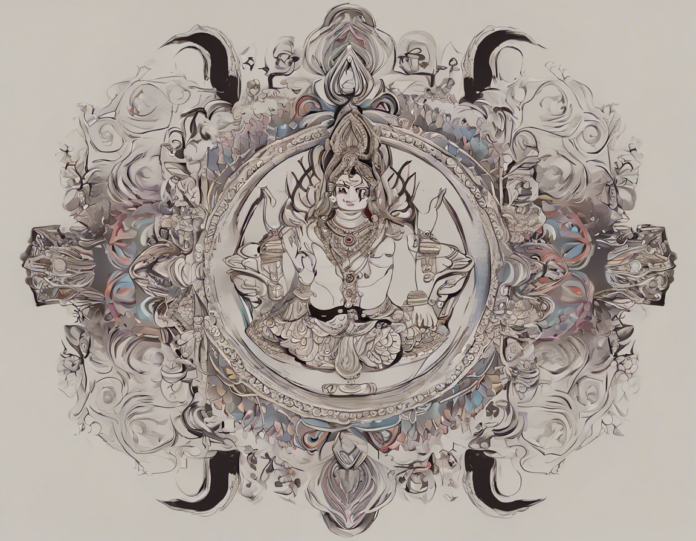Shiva, the Hindu god of destruction and transformation, is one of the most enigmatic and revered deities in the Hindu pantheon. Known by many names such as Mahadev, Shankara, and Bholenath, Shiva is worshipped by millions of devotees around the world who seek his blessings for protection, wisdom, and inner peace. In this blog post, we will delve into the eternal tales of Shiva, tracing his divine journey through the rich tapestry of Hindu mythology, symbolism, and philosophy.
The Origins of Shiva: Birth and Beyond
Shiva’s Birth: According to Hindu mythology, Shiva is said to have emerged from the primal cosmic ocean as a fiery pillar of light, the manifestation of the supreme reality known as Brahman. His birth is shrouded in mystery, with various tales attributing different origins to him, including being born from the union of Brahma and Vishnu or arising spontaneously as the ultimate reality beyond duality.
The Family of Shiva: Shiva is often depicted as the husband of Parvati, the goddess of love and devotion, and the father of Ganesha and Kartikeya. His family symbolizes the eternal cycle of creation, preservation, and destruction, with Shiva embodying the cosmic forces that govern the universe.
The Symbols and Iconography of Shiva
The Trident (Trishul): Shiva is often depicted holding a trident, symbolizing his power to destroy ignorance, ego, and desires. The three prongs of the trident represent the three gunas or qualities of nature – sattva (purity), rajas (activity), and tamas (inertia).
The Third Eye (Triambaka): Shiva is also known as Triambaka, the one with the third eye, which represents wisdom, insight, and the ability to see beyond the physical realm. When Shiva opens his third eye, it unleashes a destructive fire that annihilates evil and restores balance in the universe.
The Crescent Moon (Chandra): Shiva wears a crescent moon on his matted locks, symbolizing the cyclical nature of time, the waxing and waning of the moon, and the eternal rhythm of creation and destruction.
The Divine Consorts of Shiva
Parvati: Parvati, also known as Uma, Gauri, and Shakti, is the divine consort of Shiva and the personification of feminine energy and power. Together, Shiva and Parvati represent the union of Shiva and Shakti, the cosmic duality that gives rise to the universe and sustains all life.
Sati: Sati, the first wife of Shiva, immolated herself in the sacrificial fire of her father Daksha in protest against his disrespect towards Shiva. Sati’s act of self-sacrifice led to her rebirth as Parvati and her reunion with Shiva, symbolizing the eternal bond between husband and wife.
The Symbols of Shiva Lingam and Nandi
The Lingam: The Shiva Lingam is a symbol of the formless and infinite nature of Shiva, representing his transcendent reality beyond physical attributes. Devotees worship the Lingam as a manifestation of the cosmic pillar of light that Shiva emerged from, seeking his blessings for protection and liberation.
Nandi: Nandi, the bull, is the divine vehicle and gatekeeper of Shiva, symbolizing strength, virility, and loyalty. Nandi is often found facing the entrance of Shiva temples, embodying the devotee’s readiness to serve and surrender to the divine will of Shiva.
The Legends and Myths of Shiva
The Churning of the Ocean (Samudra Manthan): In this epic tale, gods and demons join forces to churn the cosmic ocean in search of the elixir of immortality. As the churning proceeds, a deadly poison known as halahala emerges, threatening to destroy the universe. Shiva comes to the rescue by swallowing the poison, but his consort Parvati stops it in his throat, turning his neck blue and earning him the name Neelakantha.
The Dance of Destruction (Tandava): Shiva is often depicted performing the Tandava, the cosmic dance of destruction that symbolizes the cyclical nature of creation and dissolution. The Tandava is said to represent the five activities of Shiva – creation, preservation, destruction, veiling, and revealing – and is a powerful metaphor for the cosmic dance of life.
The Philosophy of Shiva: Shaivism and Beyond
Shaivism: Shaivism is one of the major traditions within Hinduism that worships Shiva as the supreme deity. Followers of Shaivism believe in the divine nature of Shiva as the ultimate reality (Brahman) and seek to attain spiritual liberation (moksha) through devotion, meditation, and self-realization.
Shiva as Ardhanarishwara: Ardhanarishwara is a divine form of Shiva that represents the union of masculine and feminine energies in perfect harmony. In this form, Shiva embodies the inseparable relationship between Purusha (male aspect) and Prakriti (female aspect), symbolizing the unity of opposites in the cosmic dance of existence.
The Festivals and Celebrations of Shiva
Maha Shivaratri: Maha Shivaratri, the Great Night of Shiva, is one of the most important festivals dedicated to Lord Shiva. Devotees observe fasts, perform rituals, and offer prayers to seek Shiva’s blessings for health, prosperity, and spiritual upliftment.
Rudra Abhishekam: Rudra Abhishekam is a sacred Vedic ritual of bathing the Shiva Lingam with water, milk, honey, ghee, and other auspicious substances while chanting mantras and hymns in praise of Lord Shiva. The ritual is believed to purify the mind, body, and soul, and bring blessings of peace and prosperity.
Frequently Asked Questions (FAQs)
1. Who is Shiva in Hinduism?
Shiva is one of the principal deities in Hinduism, known as the god of destruction and transformation. He is worshipped for his powers of protection, wisdom, and inner peace.
2. What is the significance of the third eye of Shiva?
Shiva’s third eye symbolizes wisdom, insight, and the ability to see beyond the physical realm. When opened, it unleashes a destructive fire that destroys evil and restores balance in the universe.
3. Why is Shiva often depicted with a serpent around his neck?
The serpent around Shiva’s neck represents his mastery over the primal forces of creation and destruction. It symbolizes rebirth, transformation, and the eternal cycle of life and death.
4. What is the importance of the Shiva Lingam in worship?
The Shiva Lingam symbolizes the formless and infinite nature of Shiva, representing his transcendent reality beyond physical attributes. Devotees worship the Lingam for protection, liberation, and spiritual growth.
5. How is Shiva connected to yoga and meditation?
Shiva is considered the Adi Yogi or the first yogi in Hindu tradition, who imparted the knowledge of yoga and meditation to humanity. Many yogic practices and meditation techniques are attributed to Shiva, emphasizing mindfulness, inner peace, and self-realization.
6. What is the significance of the snake around Shiva’s neck?
The serpent around Shiva’s neck symbolizes his mastery over the deadly forces of creation and destruction. It represents rebirth, transformation, and the eternal cycle of life and death in the cosmic dance of existence.
7. How does Shiva’s role differ from other Hindu gods like Vishnu and Brahma?
Shiva is often associated with destruction and transformation, while Vishnu is known for preservation and protection, and Brahma for creation. Together, the Trimurti represents the cyclical nature of existence, with each deity playing a distinct role in maintaining cosmic order.
8. What are some popular mantras and hymns dedicated to Lord Shiva?
Some popular mantras and hymns dedicated to Lord Shiva include the Maha Mrityunjaya Mantra, the Shiva Panchakshara Stotram, and the Shiva Tandava Stotram. Chanting these sacred verses is believed to invoke Shiva’s blessings for protection, healing, and spiritual enlightenment.
9. How can one establish a personal connection with Lord Shiva?
Devotees can establish a personal connection with Lord Shiva through regular worship, meditation, and prayer. Participating in rituals, visiting sacred sites, and studying the myths and teachings of Shiva can deepen one’s spiritual bond with the divine.
10. What lessons can we learn from the tales of Shiva?
The tales of Shiva teach us the importance of balance, transformation, and surrender to the divine will. Shiva’s stories inspire us to overcome obstacles, cultivate inner strength, and embrace the cyclical nature of life with grace and wisdom.
In conclusion, the eternal tales of Shiva offer profound insights into the mysteries of existence, the power of transformation, and the beauty of divine love and devotion. By exploring the symbolism, mythology, and philosophy of Shiva, we can embark on a spiritual journey of self-discovery, inner awakening, and cosmic realization. May the grace of Lord Shiva guide us on our path towards liberation, enlightenment, and eternal bliss.

